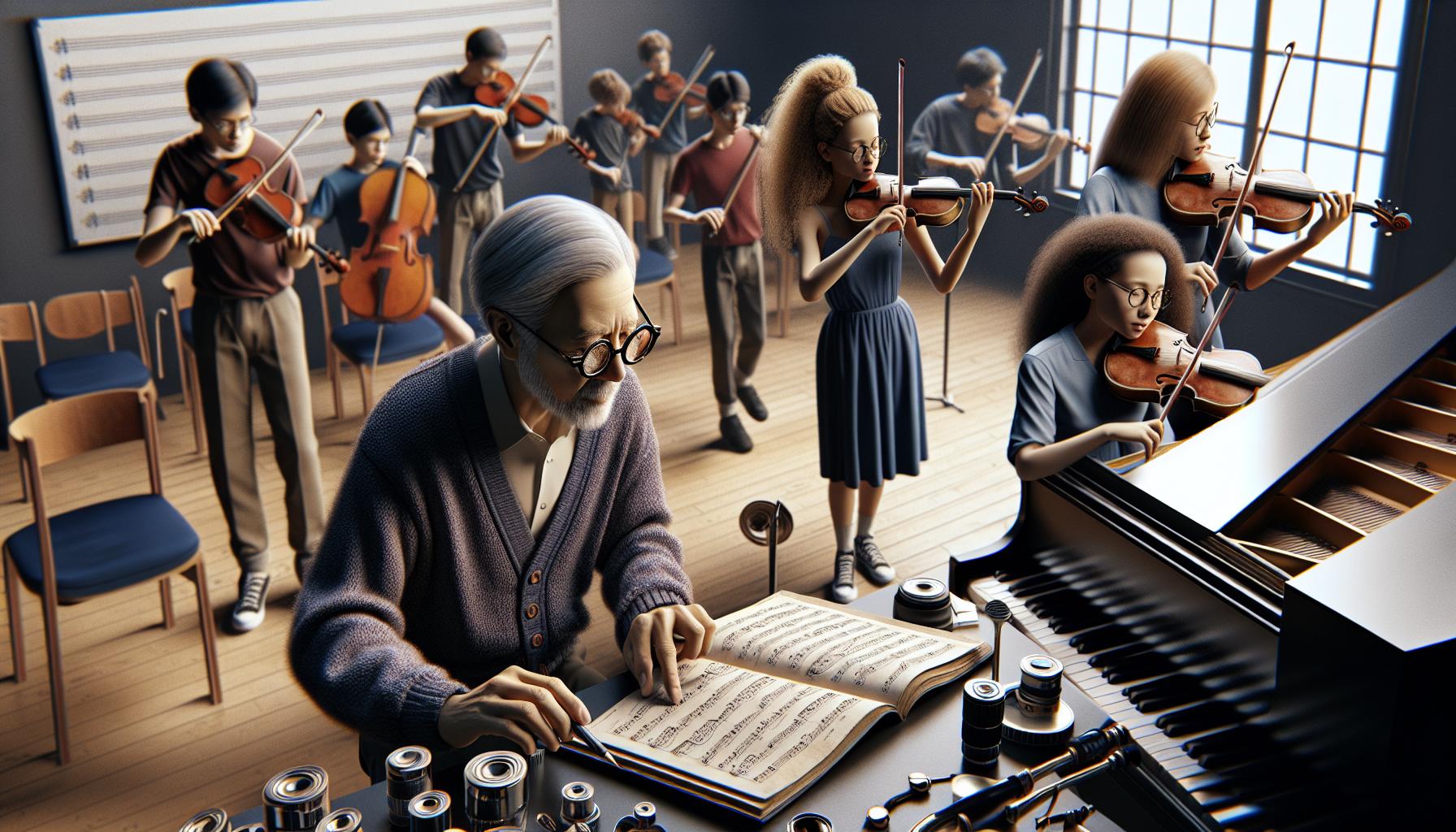Classical music stands as a timeless testament to human creativity and artistic expression spanning centuries. From the intricate compositions of Mozart to the powerful symphonies of Beethoven this genre offers a rich tapestry of musical knowledge waiting to be explored.
Learning classical music develops more than just musical abilities. Studies show that students who engage with classical music experience enhanced cognitive function improved memory and better concentration skills. Whether someone’s interested in mastering a specific instrument or simply wants to deepen their appreciation of orchestral works the journey into classical music opens doors to a world of cultural and personal enrichment.
Why Study Classical Music
Classical music education forms the foundation of advanced musical skills and cognitive development. Its complex structures provide a comprehensive framework for understanding music theory, composition and performance techniques.
Benefits for Musical Development
Classical music training enhances fundamental musical abilities through systematic progression:
- Develops precise finger dexterity through intricate passages in works like Bach’s fugues
- Builds advanced sight-reading skills by practicing complex musical notation
- Strengthens rhythm accuracy through exposure to varied time signatures
- Improves dynamic control by mastering subtle volume changes in sonatas
- Expands knowledge of musical forms including sonata allegro, rondo and theme variations
- Refines articulation techniques through detailed performance markings
| Cognitive Benefit | Improvement Percentage | Study Source |
|---|---|---|
| Memory Function | 40% increase | Nature Neuroscience 2021 |
| Focus Duration | 35% enhancement | Cognitive Psychology Review 2020 |
| Pattern Recognition | 28% improvement | Journal of Neuroscience 2022 |
- Enhances spatial-temporal reasoning through complex musical patterns
- Develops discipline through structured practice routines
- Improves emotional intelligence by interpreting musical expressions
- Reduces stress levels through focused listening sessions
- Strengthens neural pathways through multi-sensory engagement
- Boosts academic performance in mathematics and language skills
Essential Elements of Classical Music Study

Classical music study encompasses fundamental components that build a comprehensive musical foundation. These elements work together to develop both technical proficiency and artistic understanding.
Music Theory Foundations
Music theory forms the backbone of classical music comprehension. Students master key concepts including:
- Notation reading: Understanding clefs, notes, rhythms, time signatures
- Harmony analysis: Identifying chords, progressions, cadences
- Form structure: Recognizing sonata form, binary form, rondo form
- Scales patterns: Learning major, minor, chromatic scales
- Articulation marks: Interpreting staccato, legato, accent markings
| Theory Component | Beginner Level | Intermediate Level | Advanced Level |
|---|---|---|---|
| Scale Knowledge | 2-3 major scales | 12 major/minor scales | All scales + modes |
| Chord Recognition | Basic triads | 7th chords | Extended harmonies |
| Form Analysis | Binary form | Sonata form | Complex structures |
- Interval recognition: Identifying distances between notes aurally
- Rhythm dictation: Notating rhythmic patterns from listening
- Melodic dictation: Transcribing melodies accurately
- Prima vista reading: Playing unfamiliar scores at first sight
- Solfège practice: Using fixed or movable do systems
| Skill Area | Practice Duration | Weekly Sessions | Progress Markers |
|---|---|---|---|
| Ear Training | 15-20 minutes | 3-4 sessions | Identify 8 intervals |
| Sight Reading | 10-15 minutes | 5-6 sessions | Read 4 new pieces |
Getting Started with Classical Music
Starting a classical music journey begins with selecting appropriate learning tools and guidance. The following components establish a strong foundation for classical music education.
Choosing Your Instrument
Classical music study starts with selecting an instrument that matches physical capabilities and musical interests. The piano offers a comprehensive introduction to music theory with its visual keyboard layout. String instruments like violin or cello develop precise pitch recognition. Wind instruments such as flute or clarinet enhance breath control and embouchure techniques. Consider these factors when selecting an instrument:
- Space requirements: Piano needs a dedicated area while violins require minimal space
- Budget considerations: Entry-level pianos cost $3,000+ while student violins start at $300
- Physical attributes: Hand size affects piano playing, arm length impacts string instruments
- Maintenance needs: Strings require regular tuning, woodwinds need reed replacements
- Sound preferences: Each instrument produces distinct timbres and sound qualities
- Formal education: Bachelor’s degree in music or equivalent conservatory training
- Teaching experience: 5+ years of instruction with documented student achievements
- Performance background: Regular participation in orchestras or solo recitals
- Teaching methodology: Clear curriculum structure with measurable progress markers
- Communication skills: Ability to explain complex concepts in understandable terms
- Student age specialization: Experience teaching specific age groups or skill levels
- Professional memberships: Affiliations with recognized music teaching organizations
| Teacher Qualification Level | Typical Hourly Rate | Minimum Experience |
|---|---|---|
| Beginning Teacher | $30-50 | 1-2 years |
| Intermediate Level | $50-80 | 3-5 years |
| Advanced/Expert | $80-150+ | 5+ years |
Important Classical Composers and Periods
Classical music spans distinct periods marked by evolving compositional styles, instrumental advancements, and artistic philosophies. Each era contributed unique characteristics that shaped the development of Western classical music.
Baroque and Classical Eras
The Baroque era (1600-1750) featured ornate compositions characterized by complex counterpoint and dramatic expression. Key composers include:
- Johann Sebastian Bach: Created masterworks like The Well-Tempered Clavier and Mass in B Minor
- George Frideric Handel: Composed the oratorio Messiah and numerous operas
- Antonio Vivaldi: Wrote The Four Seasons and 500+ concertos
The Classical period (1730-1820) emphasized clarity, balance, and formal structure:
- Wolfgang Amadeus Mozart: Composed 41 symphonies, 27 piano concertos, and operas like The Magic Flute
- Joseph Haydn: Created 104 symphonies and established the string quartet format
- Ludwig van Beethoven (early works): Composed pioneering piano sonatas and his first six symphonies
Romantic and Modern Periods
The Romantic era (1810-1910) embraced emotional expression and programmatic music:
- Frédéric Chopin: Specialized in piano works including nocturnes, mazurkas, and études
- Pyotr Tchaikovsky: Composed ballets like Swan Lake and six symphonies
- Johannes Brahms: Created four symphonies and numerous chamber music works
- Igor Stravinsky: Revolutionized ballet music with The Rite of Spring
- Claude Debussy: Pioneered impressionist music with Clair de Lune
- Arnold Schoenberg: Developed the twelve-tone technique in compositions
| Era | Time Period | Key Characteristics |
|---|---|---|
| Baroque | 1600-1750 | Ornate, contrapuntal, dramatic |
| Classical | 1730-1820 | Balanced, structured, refined |
| Romantic | 1810-1910 | Emotional, programmatic, expansive |
| Modern | 1900-present | Experimental, diverse, innovative |
Effective Practice Techniques
Effective classical music practice combines structured routines with deliberate learning strategies. These techniques optimize skill development through focused sessions that target specific musical elements.
Creating a Practice Schedule
A consistent practice schedule prioritizes daily engagement with classical music repertoire. Musicians benefit from:
- Scheduling 30-45 minute practice blocks separated by 10-minute breaks
- Practicing at the same time each day for optimal skill retention
- Allocating specific time slots for different skills (15 minutes scales, 20 minutes repertoire)
- Recording practice sessions to track progress
- Setting weekly goals with measurable outcomes
- Maintaining a practice log to document achievements
- Starting with 5-10 minutes of warm-up exercises
- Using a metronome for precise rhythm development
- Breaking complex passages into smaller, manageable segments
- Practicing challenging sections at slower tempos (50% of final speed)
- Incorporating mental practice through score study
- Recording self-performance for objective evaluation
- Focusing on one technical challenge at a time
- Maintaining proper posture throughout practice sessions
| Practice Element | Recommended Duration | Frequency |
|---|---|---|
| Warm-up | 5-10 minutes | Daily |
| Technical exercises | 15-20 minutes | Daily |
| Repertoire study | 20-30 minutes | Daily |
| Sight-reading | 10-15 minutes | 3x weekly |
| Theory practice | 15 minutes | 2x weekly |
Performance and Appreciation Skills
Performance and appreciation skills form essential components in classical music study, enhancing both technical proficiency and deep musical understanding. These skills create a foundation for meaningful engagement with classical music, whether as a performer or listener.
Concert Etiquette
Classical concert attendance requires specific etiquette protocols to maintain an optimal listening environment. Attendees arrive 15-20 minutes before the performance start time to find seats quietly. Standard practices include:
- Silencing electronic devices before entering the concert hall
- Holding applause between movements of multi-movement works
- Remaining seated until piece completion
- Refraining from photography or recording during performances
- Avoiding conversation or whispers during the performance
- Dressing appropriately in business casual or formal attire
Active Listening Methods
Active listening transforms casual music consumption into deep musical comprehension. Key listening strategies include:
- Following specific instrumental lines throughout a piece
- Identifying recurring themes or motifs in the composition
- Tracking dynamic changes (volume variations from pianissimo to fortissimo)
- Noting tempo modifications (accelerando rubato ritardando)
- Recognizing different instrumental timbres in ensemble works
- Analyzing structural elements (exposition development recapitulation)
| Listening Tool | Purpose | Application |
|---|---|---|
| Musical Scores | Visual tracking | Following orchestral parts |
| Program Notes | Historical context | Understanding composition background |
| Recording Analysis | Compare interpretations | Studying different performances |
| Digital Apps | Interactive learning | Real-time score following |
Conclusion
Studying classical music opens doors to a rich world of artistic excellence and personal development. The journey through this timeless genre offers far more than musical proficiency – it builds cognitive strength mental discipline and cultural understanding.
Whether someone aspires to become a concert pianist or simply wants to appreciate classical masterpieces the rewards are profound. With proper guidance dedicated practice and a structured approach anyone can embark on this enriching musical journey.
The lasting impact of classical music study extends beyond the practice room shaping not just musicians but well-rounded individuals who appreciate the beauty complexity and emotional depth of this enduring art form.

